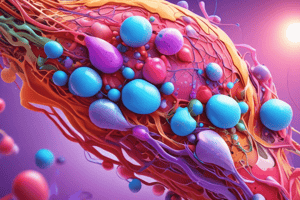Podcast
Questions and Answers
What is a key focus of the AaT Level 3 program?
What is a key focus of the AaT Level 3 program?
- Foundational healthcare practices
- Practical application and advanced techniques (correct)
- Basic anatomical concepts
- Historical development of anatomy
Which area of study at Level 3 involves detailed exploration of joints and muscle interactions?
Which area of study at Level 3 involves detailed exploration of joints and muscle interactions?
- Neuroanatomy and Neurological Function
- Cardiovascular system
- Advanced musculoskeletal anatomy (correct)
- Endocrine system
Which of these is NOT a focus area in Level 3 of the AaT program?
Which of these is NOT a focus area in Level 3 of the AaT program?
- Basic first aid techniques (correct)
- Advanced neurological disorders
- Skin function and wound healing
- Digestive physiology and metabolic processes
What type of learning method is prominent in AaT Level 3 for practicing clinical skills?
What type of learning method is prominent in AaT Level 3 for practicing clinical skills?
What is an expected outcome for students completing Level 3?
What is an expected outcome for students completing Level 3?
In which area do students explore hormonal regulation and digestive physiology at Level 3?
In which area do students explore hormonal regulation and digestive physiology at Level 3?
What advanced technique is introduced to students for therapeutic purposes?
What advanced technique is introduced to students for therapeutic purposes?
During patient case studies in Level 3, what is primarily required from students?
During patient case studies in Level 3, what is primarily required from students?
Flashcards
What is the focus of AaT Level 3?
What is the focus of AaT Level 3?
AaT Level 3 is an intermediate stage in the Applied Anatomy and Treatment program, focusing on practical applications and advanced techniques.
What kind of learning experiences are common in AaT Level 3?
What kind of learning experiences are common in AaT Level 3?
AaT Level 3 introduces more complex case studies, simulations, and hands-on projects.
How does Level 3 expand the study of neuroanatomy and neurological function?
How does Level 3 expand the study of neuroanatomy and neurological function?
Students delve deeper into the nervous system, exploring pathways, reflexes, and neurological disorders in more detail.
What is the core emphasis of advanced anatomical knowledge in Level 3?
What is the core emphasis of advanced anatomical knowledge in Level 3?
Signup and view all the flashcards
What is a key focus in advanced musculoskeletal anatomy at Level 3?
What is a key focus in advanced musculoskeletal anatomy at Level 3?
Signup and view all the flashcards
What kind of therapeutic techniques are introduced in AaT Level 3?
What kind of therapeutic techniques are introduced in AaT Level 3?
Signup and view all the flashcards
How do students develop clinical skills in Level 3?
How do students develop clinical skills in Level 3?
Signup and view all the flashcards
What are some key aspects of assessment explored in AaT Level 3?
What are some key aspects of assessment explored in AaT Level 3?
Signup and view all the flashcards
Study Notes
Understanding AaT Level 3
- AaT, or Applied Anatomy and Treatment, is a comprehensive program, and Level 3 represents an intermediate stage of study.
- Focus shifts from fundamental concepts to practical application and advanced techniques.
- Coursework often includes more complex case studies, simulations, and hands-on projects.
- Students learn advanced anatomical knowledge, linking structure to function in various systems.
Key Areas of Study at Level 3
- Advanced musculoskeletal anatomy: Detailed study of joints, muscle groups, and their interactions, including biomechanics and movement analysis.
- Neuroanatomy and Neurological Function: Deeper understanding of the nervous system, exploring pathways, reflexes, and neurological disorders.
- Cardiovascular and respiratory systems: Advanced concepts of circulation, gas exchange, pulmonary function, and cardiovascular regulation.
- Digestive and endocrine systems: Expanded knowledge of digestive physiology, hormonal regulation, metabolic processes with emphasis on homeostasis.
- Integumentary system: Skin function, wound healing, treatment, and related pathologies.
- Genitourinary system and reproductive system: Detailed anatomy, physiology, and pathologies of the reproductive and urinary systems.
Clinical Applications and Skill Development
- Patient case studies: Complex case scenarios requiring diagnosis, physiological understanding, and therapeutic recommendations.
- Clinical simulations: Practice of hands-on procedures, assessments, and intervention strategies in realistic settings.
- Therapeutic techniques: Advanced treatment methods and modalities requiring detailed anatomy and physiology knowledge.
- Practical applications of advanced anatomy: Applying anatomical knowledge to explain clinical findings, injuries, and rehabilitation strategies.
- Assessment methods: Advanced assessment techniques and diagnostic tests to identify problems accurately.
Expected Learning Outcomes
- Advanced anatomical knowledge: Comprehensive understanding of anatomical structures and their functional relationships.
- Clinical reasoning skills: Analyzing patient presentations, formulating diagnoses, devising appropriate treatment plans.
- Practical application of therapeutic techniques: Proficient application of knowledge to hands-on therapy or other treatment areas.
- Problem-solving skills: Critical thinking and problem-solving strategies to overcome challenges.
- Communication skills: Effective communication with patients and colleagues in a clinical setting.
Studying That Suits You
Use AI to generate personalized quizzes and flashcards to suit your learning preferences.




